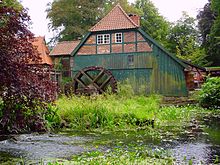Grander mill
The Grander Mühle is a water mill in the Duchy of Lauenburg ( Schleswig-Holstein ) on the banks of the Bille river in the Rotenbek district of the Kuddewörde community . The mill owes its name to the village of Grande in the Stormarn district on the other bank of the Bille. Today it is considered the oldest grain watermill in Northern Germany.
history
The Grander Mill was first mentioned in a document in 1345. According to this document, there was an old mill near Grande as early as 1303. When and by whom the mill was built is not known.
In the 14th century the Knights of Scarpenbergh are mentioned as owners. These robber barons were driven out by a contingent of the Hanseatic cities of Lübeck and Hamburg in 1349, so that the property went to the Reinbek monastery in 1351 . The next documentary evidence from 1497 shows that the mill with Kuddewörde was given to the knights of the Lieth as a fief since 1485. With the extinction of the von der Lieth line in 1585, the mill became the property of the Saxony-Lauenburg government .
The ownership changed again in 1871, when Kaiser Wilhelm I gave the then Chancellor Otto von Bismarck the Sachsenwald including the Grander mill. The mill was sold to the then mill leaseholder Caroline Sophie Schröder in 1890/91.
use
The mill was operated as a grain mill until it was closed. The right to stow , fish and drink also belonged to the mills . The tenants and later owners of the mill can be traced back to 1675.
From 1760 to 1969 the mill was operated by the Schröder / Harders / Holdeigel family as tenants and later as owners.
At the beginning of the 19th century, a barley gallery was also put into operation.
In 1897/98, in addition to the grinding operation, the generation of electricity was started. In addition to the mill, the surrounding farms in Grande and Rotenbek and the customs house were supplied with 110 volts direct current . After the village was connected to the public electricity network with an overhead line, the generator in the mill was only used for self-supply from 1928 onwards. The grinding gear was switched to an electric drive.
After straightening the Bille, the grinding operation was stopped and the owner devoted himself entirely to the restaurant business that had existed since the middle of the 19th century. The landlord sold the damming right belonging to the mill to the village community, which meant that meadows and fields were no longer flooded in spring.
After the mill was sold in 1969, the catering business declined and the mill fell into disrepair. In 1979 the mill was placed under monument protection and restored in 1980 by the “Friends of the Grander Mill” association.
Later the mill was sold again to a restaurateur who runs a restaurant in the mill. The outbuilding is used as a hotel. Until 2009, the flour hall with the new grinding aisle was used as a storage room. After extensive renovation of the catering area in 2009 and adjustments to the guest rooms, a large part of the mechanical area of the mill can now be visited again. The entrance to the restaurant, which has been in operation since the end of 2009, leads through this area.
In the fall of 2012 there was a fire in an extension and an explosion in the kitchen area, which put the east gable in danger of collapsing and the restaurant operations.
On the night of November 17, 2015, the mill was secured with sandbags by the fire brigade as a precautionary measure after days of rain. The river Bille in Kuddewörde had overflowed. The masses of water threatened to affect the historic building. The picture was repeated just three months later: on February 22, 2016, the Bille flooded its banks again and threatened the mill. The fire brigade secured the mill with sandbags and lowered the water level with pumps.
Forced meal guests
The Grander Mill was a compulsory mill until the introduction of freedom of trade in the Duchy of Lauenburg. The villages of Kasseburg , Fuhlenhagen , Grabau , Grove , Havekost , Köthel , Kuddewörde, Möhnsen , Mühlenrade , Rotenbek , Grande, Schönberg and Schwarzenbek were subject to the compulsory milling of this mill according to a lease contract from the Royal High Rent Chamber executed by the Schwarzenbek office in 1827 .
The inhabitants of the village of Talkau had freedom of meal .
Others
The Grander Mill has also achieved international recognition as a puzzle motif.
literature
- Rudolf Schlueter: The Grander Mill. pro-info-verlag Doll-Hegedo, Aumühle b. Hamburg 1986, ISBN 3-925751-00-9 .
- Maria Salzmann: The Grander Mill. Atona 1927, manuscript.
swell
- Lease agreement between the "Royal Office of Schwarzenbeck and the miller Friedrich Ernst Schröder and his wife ..." 1827
Web links
- The Grander Mill in a painting by Eugen Denzel
- Hotel Grander Mill
Individual evidence
- ↑ Stormarner Tageblatt : Grander Mühle: Flood in parts of SH , November 17, 2015
- ↑ Watermill threatened by water. In: Schleswig-Holstein Magazin . NDR , February 23, 2016, accessed on February 23, 2016 .
Coordinates: 53 ° 34 ′ 43 " N , 10 ° 23 ′ 25" E
